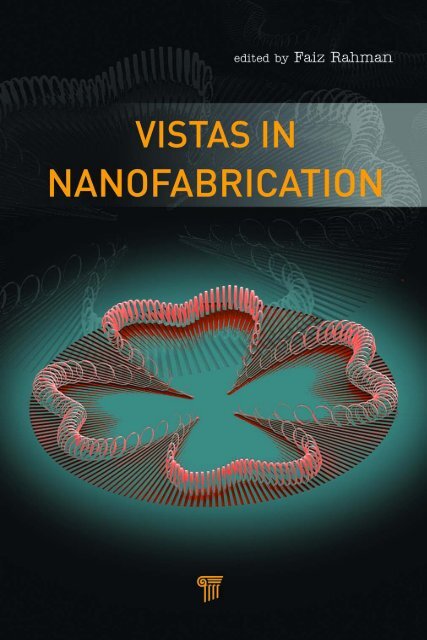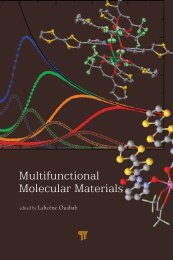Download PDF - Pan Stanford Publishing
Download PDF - Pan Stanford Publishing
Download PDF - Pan Stanford Publishing
Create successful ePaper yourself
Turn your PDF publications into a flip-book with our unique Google optimized e-Paper software.
Published by<strong>Pan</strong> <strong>Stanford</strong> <strong>Publishing</strong> Pte. Ltd.Penthouse Level, Suntec Tower 38 Temasek BoulevardSingapore 038988Email: editorial@panstanford.comWeb: www.panstanford.comBritish Library Cataloguing-in-Publication DataA catalogue record for this book is available from the British Library.Vistas in NanofabricationCopyright © 2013 by <strong>Pan</strong> <strong>Stanford</strong> <strong>Publishing</strong> Pte. Ltd.All rights reserved. This book, or parts thereof, may not be reproduced in any formor by any means, electronic or mechanical, including photocopying, recordingor any information storage and retrieval system now known or to be invented,without written permission from the publisher.For photocopying of material in this volume, please pay a copying fee throughthe Copyright Clearance Center, Inc., 222 Rosewood Drive, Danvers, MA 01923,USA. In this case permission to photocopy is not required from the publisher.ISBN 978-981-4364-56-0 (Hardcover)ISBN 978-981-4364-57-7 (eBook)Printed in the USA
viiiContents6.2 Experimental Details 1196.2.1 Fabrication of the Electrodes 1196.2.2 Nanoparticle Synthesis 1206.2.3 Langmuir–Blodgett Film Preparation 1206.2.4 Microsphere Preparation 1216.2.5 Electrical Measurements 1216.3 Results and Discussion 1216.3.1 Nanotrench 1216.4 Demonstration Devices 1236.4.1 Highly Resistive Magnetic NanoparticlesArrays for Magnetoresistive Devices 1236.4.2 High-Current Devices 1256.5 Conclusion 1277. High-Aspect-Ratio Metallic Nanostructures forTransparent Electrodes 133Joong-Mok Park, Xinyu Liu, Wai Leung, Kristen Constant,Alan Russell, and Kai-Ming Ho7.1 Introduction 1347.2 Fabrication of Nanowire Using Polymer Templates 1347.2.1 Polymer Template Fabrication 1347.2.2 Metal Deposition 1377.3 Characterization of Nanowires 1387.3.1 Transmission Electron Microscopy 1387.3.2 In situ Grain Growth 1407.4 Shadow Angle Deposition 1417.4.1 Shadow Deposition of Metal Nanowires 1417.4.2 High-Aspect-Ratio MetallicStructures by Ar Etching 1427.4.3 Electrical and Optical Properties 1437.5 Conclusions 1448. Fabrication of Nanogap Electrodes by ElectrolessandElectro Deposition 147Luis De Los Santos Valladares, Angel BustamanteDomínguez, Thanos Mitrelias, Crispin H.W. Barnes,J. Albino Aguiar, and Yutaka Majima8.1 Introduction 1488.2 Nanogap Electrodes Obtained byElectroless Deposition 150
Contentsix8.2.1 Fabrication of Gold Nanogaps 1518.2.1.1 The electrolyte 1528.2.1.2 Nanogap formation 1538.2.2 Characterization 1548.3 Nanogap Electrodes Obtained by Electrodeposition 1568.3.1 Fabrication of Nickel Nanogaps 1598.3.1.1 The electrolyte 1598.3.1.2 Nanogap formation 1628.3.2 Characterization 1659. Nanometer-Scale Processing by TribologicalAction and Its Potential Applications 175Shojiro Miyake and Mei Wang9.1 Introduction 1759.2 Nanoprocessing Methods and Tribology 1769.2.1 AFM Nanoprocessing 1769.2.2 Nanotribology and Nanofabrication 1789.3 Tribomechanical Processing andApplication of Etching Mask for Silicon 1799.4 Nanofabrication and its Application based onthe Structure of the Workpiece Material 1829.4.1 Nanoprocessing of Layered CrystalMaterials at the Layer Unit 1829.4.2 Nanoprocessing of NanoperiodMultilayer Films 1849.4.3 Application of AFM to Ultrahigh-DensityMemory 1869.4.4 Application of Nano and Micromachines 1879.4.5 Application of Standard of Length Scale 1899.5 Conclusions 19010. Nanomaterial Integration on CMOS Platform 193Sumita Santra, Prasanta Kumar Guha, and Florin Udrea10.1 Introduction 19310.2 Nanostructure Fabrication 19410.3 CMOS and Nanomaterials 19410.3.1 Advantages of Integration 19510.3.2 Integration Challenges 19510.4 Nanomaterial Synthesis on CMOS Platform 19610.4.1 Hydrothermal Method 196
xContents10.4.2 Local Growth Technique 19710.4.3 Flame Spray Pyrolysis 20110.4.4 Aerosol-Assisted Chemical Vapour Deposition 20310.4.5 Inkjet Printing/Spray Coating 20310.5 Conclusion 20411. Focused Ion Beam Fabrication of MetallicNanostructures 207Michal Urbánek and Tomáš Šikola11.1 Introduction 20711.2 Focused Ion Beam Systems 20811.3 Milling of Metallic Thin Films 20911.3.1 Evolution of the Milling Process forMetallic Thin Film on Silicon Substrate 21111.3.2 Estimation of the Ion Dose Needed forThin Film Removal 21311.4 Influence of Ion Beam Parameters 21311.5 Contacting the Structures 21611.6 Summary 21712. Nanotechnology Showcase 221Size-Tunable Silicon Nanopore Arrays 221Self-Organizing Array of Spiral Nanoribbons 223ZnO Nanowire Photonic Arrays 225Nanostructure Cu 2 O Films: Preparation,Characterization, and Properties 227Chemical Fabrication of Nanogaps forSingle-Molecule Electronics 229Noncatalytic Synthesis of Carbon Nanotubes on SiC 231Magnetic Microtags for Color MRI 233Solution-Processible Fabrication ofGold Nanostructures 235Resonant Tunneling Nanotransistor fromIII-V Compound Semiconductor Heterostructures 238Index 241
ContentsxiPrefaceNew materials and devices derived from the application ofmanufacturing technologies where objects are manipulated atultra-small scales are becoming gradually commonplace. Modifyingmaterials at micrometre and nanometre scales is often crucialto endowing them with properties that are not found in the basematerial. Sometimes this is done to gain economic and performancebenefits, such as in the manufacture of integrated circuits with eversmallerfeatures. At other times, nanofabrication is utilised to obtaincompletely new functionalities, such as in making antireflectionstructures on plastics and glasses. The relatively new discipline ofnanotechnology is now finding increasing use in the manufactureof a wide variety of products, ranging from pharmaceuticals andperformance chemicals to apparels and electronic devices. Thisrange continues to expand as new process tools and technologiesare developed in research laboratories around the world, on a dailybasis. It is now a firmly established fact that the importance ofnanotechnology will only increase in the years to come as it makesfurther inroads into almost every area of human activity. We arealready seeing the migration of nanofabrication technologies fromthe traditional area of electronics manufacturing to other fields suchas environmental protection, high-performance sporting goods,manufacture of decorative objects, and other products for everydayuse. Despite the increasing use of nanotechnology for producingsuch goods, its primary application remains in electronics andoptoelectronics. This is understandable because further increasesin performance of electronic and optoelectronic components willcome, to a large extent, from the application of clever nanofabricationtechniques in device manufacture. Thus, for example, the continuedminiaturization of silicon integrated circuits will become impossibleas minimum feature dimensions gradually decrease below 10nm and then new materials and device architectures — drivenby continuing advances in nanotechnology — will be needed tomaintain the evolution of circuits and devices towards even higherperformance levels. For reasons such as this, a great deal of effort
xiiPrefaceis being invested in developing and identifying new materials andprocesses that can sustain the industries of the future. The contentsof this book provide a glimpse of the work being carried out bynanotechnologists in developing novel technologies for materialmanipulation and structural nanofabrication. Each chapter presentsthe recent work of a leading researcher or a research group workingat the frontiers of nanotechnology research. A special section at theend of the book presents a collection of micrographs that highlight avariety of structures being created at micron and sub-micron scales.Following is a brief description of the chapters.The use of nanosphere lithography for patterning dense surfacefeatures is described by Hirotaka Oshima from Fujitsu Laboratoriesin Chapter 1. This is followed by a detailed overview of dry etchingtechnologies for semiconductor manufacture in Chapter 2, by S. J.Pearton from the University of Florida. Basudev Lahiri from theNational Institute of Standards and Technology describes his workon split ring-based metamaterials in Chapter 3. I and my colleaguespresent our work on the fabrication of nanotextured photoniccrystal light-emitting diodes in Chapter 4. Chapter 5, contributed byJin-Seo Noh and colleagues from Yonsei University, deals with thefabrication of nano-wires. A nanotrench-based process for advancedphotolithography is described in Chapter 6, by Jean-Francois Dayenand colleagues from the University of Strasbourg. Joong-Mok Parkand colleagues from a US research consortium in Iowa describe theirwork on high-aspect-ratio structures for transparent electrodesin Chapter 7. The fabrication of nano-gap electrodes by novelnanofabrication techniques is described in Chapter 8 by Luis DeLos Santos Valladares from an international research collaboration.Chapter 9 contains a description of nanometre-scale processing bytribological techniques by Shojiro Miyake from Nippon Institute ofTechnology and Mai Wang from the OSG Corporation. Sumita Santraand colleagues from the University of Cambridge and the IndianInstitute of Technology describe the integration of nanomaterialsin CMOS processing technology in Chapter 10. The next chapter,by Michal Urbanek and Tomáš Šikola from Brno University ofTechnology describes the use of focussed ion beam techniques formaking metallic nanostructures. The section titled “TechnologyShowcase” presents a compilation of micrographs from the world ofnanotechnology.
PrefacexiiiIn putting together this collection of contemporary work onnanofabrication technologies, the editor and the contributors hope tohighlight some of the most rapidly developing techniques for microandnano-manipulation for modern nanoscale device fabrication.This collection of chapters from leading technologists providesa good survey of the state of the art in some of the most activeresearch areas in nanotechnology at present. We hope that this bookwill be of use to both new researchers involved with nanofabricationtechnologies and practicing engineers and scientists who wish toupdate their knowledge in this fast-changing field.Faiz RahmanGlasgow, United KingdomJune 2012
















